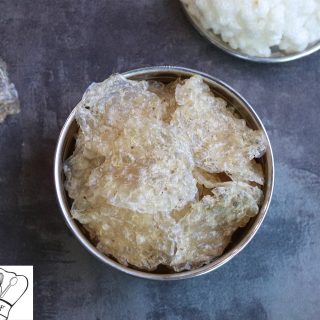
Ingredients
- Javvarisi - 2 cups use the small pearls
- Water - 10 cups
- Green chilli - 5 adjust according to your taste
- Hing - generous pinch
- Salt - as needed
- Lemon juice - 2 tbsp adjust according to your tang
Instructions
- Wash sago once to remove any impurities. Avoid washing a lot as we need the starch for vadam
- Soak sago at least for 2 - 3 hrs. I generally soak it overnight with 5 cups of water
- Add the sago along with soaked water. Furthermore, add 3 cups of water and close with a lid
- Pressure cook for 3 whistles and let the pressure release naturally
- In a mixie jar add green chilli, hing, salt, and little water; grind the chilli
- In a wide heavy bottomed vessel add 1 cup of water and ground green chilli; let it boil
- When it is boiling well add the cooked sago
- Add 1 cup of water to the cooked sago vessel. Mix well before adding water
- I felt the javvarisi required some more hing flavor and some salt so added some hing and salt
- Mix well and let it boil well
- Turn off and let it cool down
- Squeeze lemon juice and add a pinch of salt
- Place a parchment paper or cloth in the yard and add stones or some firm object at the corners for support
- Take a small portion of the mixture and add a little water if it’s too thick. It should not be in a pourable consistency. Dry Vadam might stick to the cloth if it is in a pourable consistency
- Add a small ladle full of mixture and place in a spreadable way
- Leave a gap and repeat for the entire batch
- Let it dry well in the sun. Based on the direction of the adjust the sheet during the day
- If it is a good sunny day you can easily flip the Vadam past noon
- Flip the Vadam when it is easy to flip and let it dry till sunset
- Take it inside the home for the night. The next day dry it again. Flip once in a while for even drying
- Repeat for 2-3 days till the Vadam is completely dry
- Store it in an airtight container
- Fry the Vadam in hot oil and flip for even cooking
Video
Subscribe to my YouTube channelCheck out Traditionally Modern Food!
Notes
- Adjust the water according to the type of sago you use
- If you are cooking the sago directly it in the pan, press it in between the fingers. If it is soft in middle it means sago is cooked properly
- If some sago is whitish in middle it doesn’t mean it is not cooked. As it cools the whitish part will turn transparent
- Sundry the javvarisi Vadam well before consuming
- Avoid cooking sago directly in a pressure cooker as there is a high chance of them getting burnt
- Always Store vadam in an airtight container and deep fry in oil when required
- If you try to fry the vadam that is not dried properly it will burst in the oil because of the moisture so always dry vadam well
- I have used only mild spice considering my son, but if you have a tolerance to spice, adjust accordingly
- After the vadam porridge consistency is reached, taste the porridge and adjust the spice and salt.
- Always for papad, we need to add a little less salt than usual because upon drying we feel the vadam is saltier
Tried this recipe?Mention @traditionallymodernfood or tag #traditionallymodernfood!